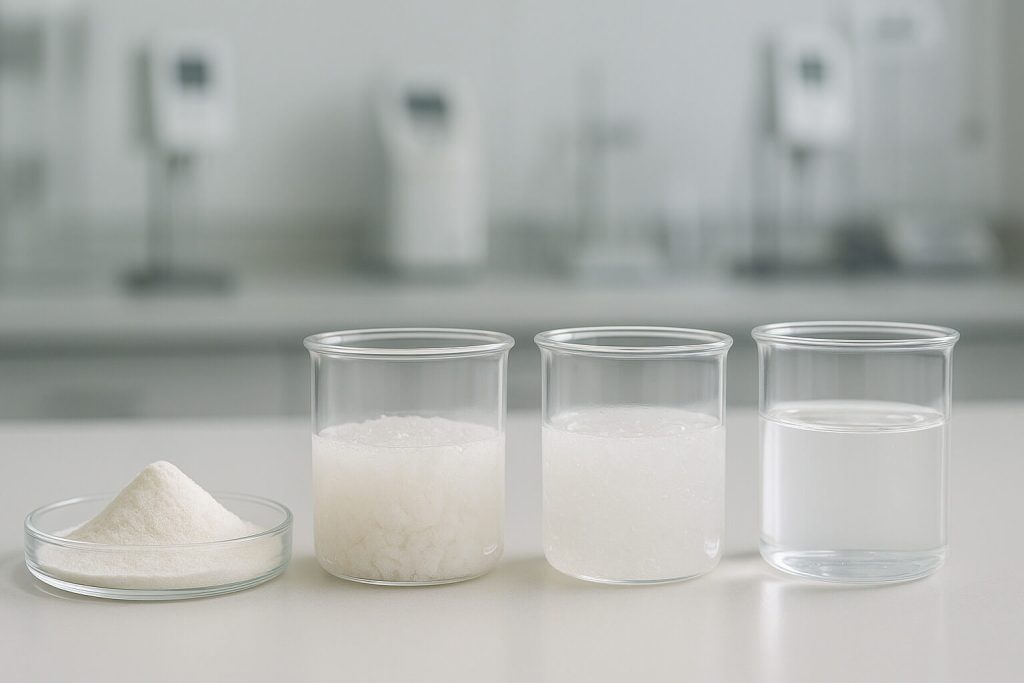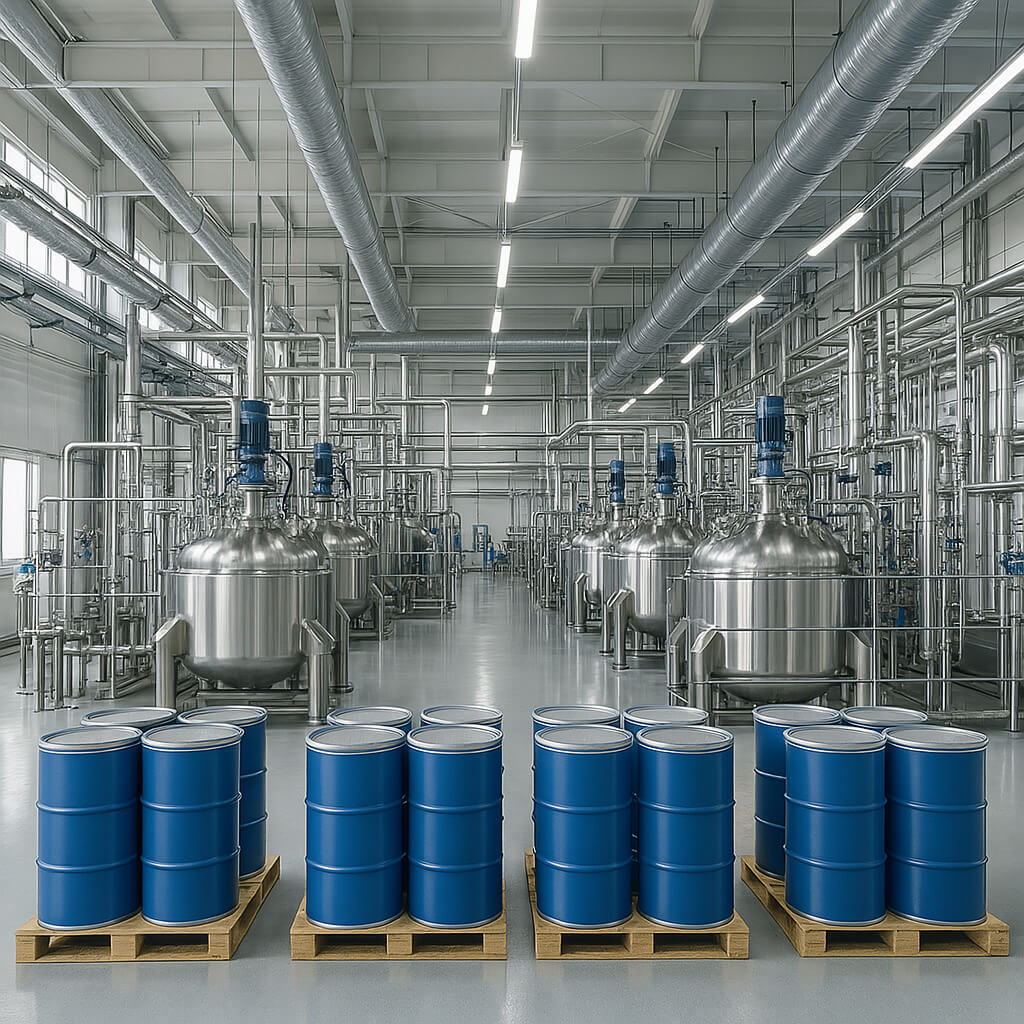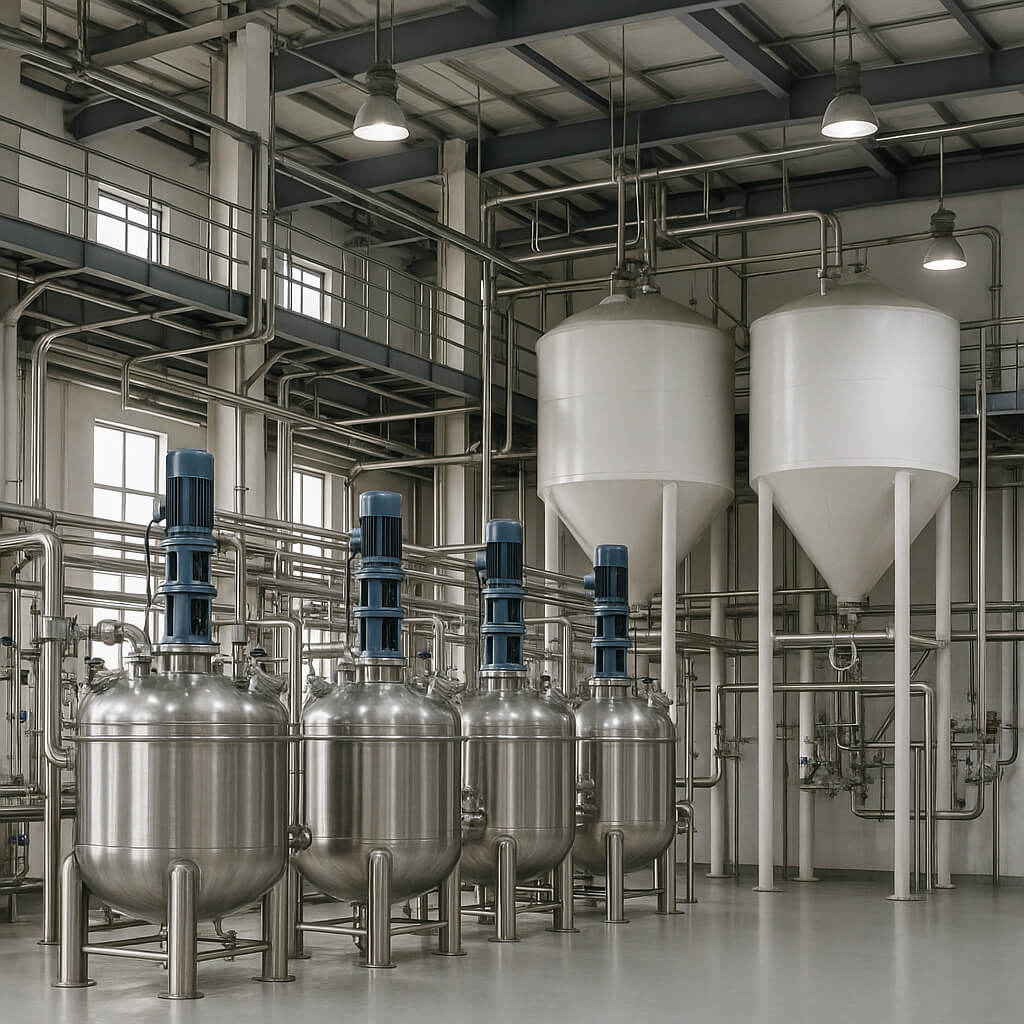Hydroxypropylmethylcellulose (HPMC) ist eine äußerst vielseitige und wichtige Verbindung, die in verschiedenen Branchen eingesetzt wird. Die physikochemischen Eigenschaften von HPMC – wie Löslichkeit, Viskosität und Molekularstruktur – sind entscheidend für ihre breite Anwendung in der Pharma-, Lebensmittel-, Bau- und Kosmetikindustrie. Das Verständnis dieser Eigenschaften ist entscheidend für die optimale Leistung von HPMC in verschiedenen Formulierungen. In diesem Artikel gehen wir detailliert auf die wichtigsten physikochemischen Eigenschaften von HPMC ein, erklären, wie sie sich auf seine industriellen Anwendungen auswirken, und vermitteln ein klares Verständnis dafür, warum diese Eigenschaften für das Erreichen der gewünschten Ergebnisse entscheidend sind.

1. Was sind die physikochemischen Eigenschaften von HPMC?
HPMC, ein Cellulosederivat, wird aufgrund seiner einzigartigen physikochemischen Eigenschaften wie Löslichkeit, Viskosität und thermischer Stabilität häufig eingesetzt. Der Clou: Seine Eigenschaften lassen sich individuell an die spezifischen Anforderungen verschiedener Branchen anpassen. Die Löslichkeit von HPMC ist eine seiner wichtigsten Eigenschaften. Je nach Substitutionsgrad ist es sowohl in kaltem als auch in heißem Wasser gut löslich und eignet sich daher gut für pharmazeutische Suspensionen, Lebensmittelformulierungen und sogar Baumaterialien wie Fliesenkleber.
Die Viskosität ist eine weitere wichtige Eigenschaft von HPMC. Sie lässt sich anpassen, um Lösungen mit unterschiedlicher Dicke zu erzeugen, was besonders bei Anwendungen nützlich ist, bei denen die Kontrolle des Flüssigkeitsflusses wichtig ist. Beispielsweise hilft die Viskosität bei pharmazeutischen Tabletten, die Freisetzungsrate des Medikaments zu kontrollieren. Auch im Bauwesen wird die Viskosität von HPMC genutzt, um die Verarbeitbarkeit und Haftung von Mörtel und Klebstoffen zu verbessern.
Die thermische Stabilität ist ein weiteres Merkmal, das HPMC für industrielle Anwendungen so attraktiv macht. HPMC behält seine Eigenschaften über einen weiten Temperaturbereich, was besonders in der Lebensmittel- und Pharmaindustrie wichtig ist, wo Temperaturschwankungen häufig vorkommen. Diese Stabilität stellt sicher, dass die Verbindung in verschiedenen Umgebungen und Bedingungen wirksam bleibt.
| Eigentum | Bedeutung | Wichtige Anwendungen |
|---|---|---|
| Löslichkeit | Hohe Löslichkeit in Wasser | Pharma, Lebensmittel, Kosmetik |
| Viskosität | Einstellbar für unterschiedliche Dicken | Pharmazeutika, Bau |
| Thermische Stabilität | Behält seine Eigenschaften bei unterschiedlichen Temperaturen | Lebensmittel, Pharma, Bau |
2. Wie beeinflusst die Molekularstruktur von HPMC seine Eigenschaften?
Die Molekularstruktur von HPMC beeinflusst direkt seine physikochemischen Eigenschaften und damit seine Funktionalität in verschiedenen Anwendungen. Bereit für den guten Teil? HPMC wird aus Zellulose gewonnen, wurde aber chemisch mit Hydroxypropyl- und Methylgruppen modifiziert. Diese Modifikationen machen HPMC wasserlöslicher und verbessern seine Leistung unter verschiedenen Bedingungen.
Der Substitutionsgrad (DS) – die Anzahl der durch Hydroxypropyl- und Methylgruppen ersetzten Hydroxylgruppen – spielt eine wichtige Rolle für die Löslichkeit und Viskosität von HPMC. Ein höherer DS führt zu einem besser löslichen Produkt und einer höheren Viskosität, was für die gewünschte Konsistenz in der Pharma-, Lebensmittel- und Bauindustrie entscheidend sein kann.
In der Pharmaindustrie ermöglicht die Molekülstruktur den Einsatz von HPMC als Bindemittel in Tablettenformulierungen oder als Wirkstoff zur kontrollierten Freisetzung. Die Methylgruppen erhöhen die Löslichkeit der Verbindung und erleichtern so die Aufnahme der Wirkstoffe in den Körper. Die Hydroxypropylgruppen hingegen verbessern die Wasserbindungsfähigkeit der Verbindung, was für die Stabilität des Endprodukts entscheidend ist.
Im Bauwesen ist die Molekularstruktur von HPMC für seine Fähigkeit verantwortlich, die Wasserrückhaltung und Haftung von Mörtel, Fliesenkleber und Putz zu verbessern. Das Vorhandensein von Methyl- und Hydroxypropylgruppen sorgt dafür, dass HPMC eine stabile, kohäsive Mischung bilden kann, die während der Anwendung verarbeitbar bleibt.
| Änderung | Auswirkungen auf Eigenschaften | Anwendungsvorteile |
|---|---|---|
| Hydroxypropyl | Verbessert die Wasserretention | Verbessert Stabilität und Textur |
| Methyl | Erhöht die Löslichkeit | Verbesserte Aufnahme von Arzneimitteln |
| Substitutionsgrad | Höherer DS = höhere Viskosität | Verbesserte Formulierungskontrolle in verschiedenen Branchen |
3. Warum sind die Löslichkeit und die hydrophilen Eigenschaften von HPMC wichtig?
Die Löslichkeit und Hydrophilie von HPMC machen es zu einer idealen Verbindung für verschiedene industrielle Anwendungen, insbesondere in der Pharma- und Lebensmittelindustrie. Der Clou: Dank dieser Eigenschaften löst sich HPMC bei unterschiedlichen Temperaturen in Wasser auf und ist daher vielseitig in verschiedenen Formulierungen einsetzbar.
In der Pharmaindustrie ist die Löslichkeit von HPMC für seine Rolle in Suspensionen und Tabletten mit kontrollierter Wirkstofffreisetzung entscheidend. Da sich HPMC sowohl in kaltem als auch in heißem Wasser auflöst, eignet es sich hervorragend für Produkte, die eine präzise Kontrolle der Wirkstofffreisetzung erfordern. Durch die Anpassung der HPMC-Konzentration können Pharmahersteller die Geschwindigkeit beeinflussen, mit der sich die Wirkstoffe auflösen und in den Körper freigesetzt werden. So wird sichergestellt, dass das Medikament über einen längeren Zeitraum in der richtigen Dosierung abgegeben wird.
Für Lebensmittelanwendungen eignen sich HPMCs hydrophile Eigenschaften ideal als Stabilisator und Emulgator. In Milchprodukten und pflanzlichen Lebensmitteln trägt HPMC zur Verbesserung der Textur bei und verhindert die Trennung der Zutaten. Darüber hinaus dient es als Verdickungsmittel in Soßen, Dressings und Suppen und verbessert die Konsistenz und das Mundgefühl des Produkts.
In der Kosmetik wird HPMC aufgrund seiner feuchtigkeitsspeichernden und texturverbessernden Eigenschaften von Lotionen, Shampoos und Cremes eingesetzt. Die hydrophile Natur von HPMC trägt zur Bildung glatter, stabiler Emulsionen bei und macht es zu einem wichtigen Bestandteil von Körperpflegeprodukten.
| Anwendung | Funktion der Löslichkeit und hydrophilen Eigenschaften | Produktleistung |
|---|---|---|
| Pharmazeutika | Kontrollierte Freisetzung, Suspensionen | Präzise Wirkstofffreisetzung, Stabilität |
| Essen | Stabilisator, Emulgator | Verbesserte Textur, Konsistenz |
| Kosmetika | Feuchtigkeitsspeicherung, Texturverbesserung | Glatte, stabile Emulsionen |
4. Wie reagiert HPMC auf pH- und Temperaturänderungen?
HPMC ist für seine Stabilität und Vielseitigkeit bekannt, sein Verhalten kann jedoch je nach Umgebungsfaktoren wie pH-Wert und Temperatur variieren. Was steckt dahinter? Die pH- und Temperaturempfindlichkeit von HPMC macht es besonders wertvoll für Anwendungen, bei denen sich die Bedingungen während der Verarbeitung oder Verwendung ändern können.
Bei neutralem bis alkalischem pH-Wert bleibt HPMC stabil und eignet sich daher ideal für eine Vielzahl pharmazeutischer und kosmetischer Formulierungen. Bei stark sauren oder stark basischen pH-Werten können sich Löslichkeit und Viskosität von HPMC jedoch verändern. So kann beispielsweise in der Pharmaindustrie die Anpassung des pH-Werts die Löslichkeit von HPMC und damit die Freisetzungsgeschwindigkeit von Wirkstoffen aus einer Tablette oder Suspension beeinflussen.
Auch die Temperatur spielt eine wichtige Rolle für die Leistung von HPMC. Mit steigender Temperatur nimmt die Viskosität von HPMC-Lösungen tendenziell ab. Diese Temperaturempfindlichkeit ist besonders wichtig in der Lebensmittel- und Pharmaindustrie, wo während der Herstellung oder Lagerung erhitzt oder gekühlt wird. Hersteller können diese Eigenschaft nutzen, um den Fluss und die Konsistenz von Produkten während der Produktion zu kontrollieren.
Was bedeutet das? Durch die Möglichkeit, pH-Wert und Temperatur zu kontrollieren, können Hersteller die Eigenschaften von HPMC für spezifische industrielle Anforderungen optimieren und so eine gleichbleibende Produktqualität und Leistung sicherstellen.
| Zustand | Auswirkungen auf das HPMC-Verhalten | Auswirkungen auf die Anwendung |
|---|---|---|
| pH (neutral) | Stabile Löslichkeit und Viskosität | Ideal für Pharmazeutika und Lebensmittel |
| pH (Sauer/Alkalisch) | Veränderte Viskosität, Löslichkeit | Erfordert Anpassungen in der Formulierung |
| Temperatur | Die Viskosität nimmt mit der Wärme ab | Wichtig für Lebensmittel, Pharma und Kosmetik |
5. Welche Rolle spielt das Molekulargewicht von HPMC für seine physikochemischen Eigenschaften?
Das Molekulargewicht von HPMC ist ein entscheidender Faktor für seine Löslichkeit, Viskosität und Gelbildungseigenschaften. Bereit für den guten Teil? Das Molekulargewicht von HPMC spielt eine direkte Rolle für seine Leistung in verschiedenen Anwendungen, da es das Gesamtverhalten der Verbindung steuert.
Ein höheres Molekulargewicht führt typischerweise zu einer höheren Viskosität und einer dickeren Lösung. Dies ist besonders nützlich bei pharmazeutischen Formulierungen, bei denen eine hochviskose HPMC-Qualität benötigt wird, um die Freisetzung von Wirkstoffen zu kontrollieren. Hochmolekulares HPMC wird auch in dickeren Gelformulierungen und zur Herstellung von Filmen für Tabletten mit kontrollierter Freisetzung verwendet.
HPMC-Typen mit niedrigerem Molekulargewicht hingegen sind leichter löslich und weisen eine geringere Viskosität auf, wodurch sie sich für Anwendungen wie Suspensionen, Beschichtungen und Emulsionen eignen. In der Lebensmittelindustrie wird HPMC mit niedrigerem Molekulargewicht häufig verwendet, um die Textur zu verbessern, ohne das Produkt zu dickflüssig zu machen.
Im Bauwesen beeinflusst das Molekulargewicht von HPMC dessen Wasserbindungsfähigkeit, die für die Verarbeitbarkeit und Haftung von Mörtel, Klebstoffen und Putzen entscheidend ist. Hersteller können das Molekulargewicht von HPMC anpassen, um in verschiedenen Formulierungen das gewünschte Gleichgewicht zwischen Leistung und Benutzerfreundlichkeit zu erreichen.
| Molekulargewicht | Viskosität und Löslichkeit | Typische Verwendungen |
|---|---|---|
| Hoch | Hohe Viskosität, geringe Löslichkeit | Tabletten und Gele mit kontrollierter Wirkstofffreisetzung |
| Niedrig | Niedrige Viskosität, hohe Löslichkeit | Suspensionen, Beschichtungen, Emulsionen |
6. Wie wirken sich die chemischen Modifikationen von HPMC auf seine Anwendungen aus?
HPMC wird chemisch modifiziert, um spezifische industrielle Anforderungen zu erfüllen. Diese Modifikationen beeinflussen seine Eigenschaften und Leistung erheblich. Hier wird es interessant: Der Substitutionsgrad, also die Anzahl der durch Hydroxypropyl- und Methylgruppen ersetzten Hydroxylgruppen, ist ein entscheidender Faktor für die Leistung von HPMC in verschiedenen Anwendungen.
Ein höherer Substitutionsgrad führt beispielsweise zu einer besseren Löslichkeit und einer höheren Viskosität und eignet sich daher ideal für den Einsatz in pharmazeutischen Tabletten, Systemen mit kontrollierter Freisetzung und Verdickungsmitteln für Lebensmittel. Umgekehrt kann ein niedrigerer Substitutionsgrad für Anwendungen bevorzugt werden, bei denen eine geringere Viskosität oder eine schnellere Auflösung erforderlich ist.
Im Bauwesen beeinflusst der Substitutionsgrad die Wasserrückhaltefähigkeit und Verarbeitbarkeit von Mörtel und Klebstoffen. Hochsubstituiertes HPMC bietet eine verbesserte Wasserrückhaltefähigkeit und eignet sich daher für den Einsatz in Fliesenklebern und Putzformulierungen. Niedrigsubstituiertes HPMC wird eingesetzt, wenn eine schnellere Abbindezeit gewünscht ist.
Durch die Flexibilität bei der Modifizierung der chemischen Struktur von HPMC können Hersteller die Eigenschaften an unterschiedliche industrielle Anforderungen anpassen und so die Produktleistung in zahlreichen Sektoren verbessern.
| Substitutionsgrad | Viskosität und Löslichkeit | Anwendung |
|---|---|---|
| Hoch | Hohe Viskosität, hohe Löslichkeit | Pharmazeutika, Bau |
| Niedrig | Niedrige Viskosität, schnelle Auflösung | Schnellhärtende Klebstoffe, Beschichtungen |
7. Welche praktischen Anwendungen gibt es für HPMC aufgrund seiner physikochemischen Eigenschaften?
Die physikochemischen Eigenschaften von HPMC machen es ideal für eine Vielzahl industrieller Anwendungen. Der Clou: Die Vielseitigkeit von HPMC ermöglicht den Einsatz in der Pharma-, Lebensmittel-, Bau- und Kosmetikindustrie – jeweils mit spezifischen Anforderungen.
In der Pharmaindustrie wird HPMC als Bindemittel in Tabletten, als Suspensionsmittel in flüssigen Formulierungen und als Wirkstoff zur kontrollierten Freisetzung eingesetzt. Seine Fähigkeit, die Auflösungsrate von Wirkstoffen zu kontrollieren, gewährleistet eine optimale Freisetzung der Wirkstoffe mit der gewünschten Geschwindigkeit und verbessert so die therapeutischen Ergebnisse.
In der Lebensmittelindustrie werden die Löslichkeits- und Viskositätseigenschaften von HPMC genutzt, um Emulsionen zu stabilisieren, die Textur zu verbessern und Produkte zu verdicken. Es wird häufig in Milchprodukten, pflanzlichen Lebensmitteln und Soßen verwendet, um die Konsistenz zu erhalten und eine Trennung zu verhindern.
Im Bauwesen verbessert HPMC die Verarbeitbarkeit, Haftung und Wasserrückhaltefähigkeit von Mörtel, Klebstoffen und Putzen. Seine Fähigkeit, Wasser zu binden, sorgt dafür, dass diese Produkte während der Anwendung verarbeitbar bleiben, während seine hohe Viskosität die Haftfestigkeit verbessert.
In der Kosmetik ist HPMC aufgrund seiner Fähigkeit, Feuchtigkeit zu speichern und glatte, stabile Emulsionen zu bilden, ein wichtiger Bestandteil von Lotionen, Shampoos und Cremes. Seine verdickenden Eigenschaften verbessern die Textur und Haptik von Körperpflegeprodukten.
| Industrie | Anwendung von HPMC-Eigenschaften | Produktleistung |
|---|---|---|
| Pharmazeutika | Kontrollierte Freigabe, Suspensionen, Bindung | Konsistente Wirkstofffreisetzung, Stabilität |
| Essen | Textur, Stabilisierung, Emulgierung | Verhindert Trennung, verbessert die Textur |
| Konstruktion | Wasserrückhaltung, Haftung, Verarbeitbarkeit | Einfachere Anwendung, bessere Haftung |
| Kosmetika | Feuchtigkeitsspeicherung, Emulgierung | Verbesserte Textur, glatte Anwendung |
8. Wie können die physikochemischen Eigenschaften von HPMC für verschiedene Branchen optimiert werden?
Durch die Optimierung der physikochemischen Eigenschaften von HPMC können Hersteller dessen Leistung an spezifische Branchenanforderungen anpassen. Und hier wird es interessant: Die Anpassung des Substitutionsgrads, des Molekulargewichts und der Konzentration von HPMC kann dessen Verhalten in verschiedenen Anwendungen erheblich beeinflussen.
In der Pharmaindustrie können Hersteller die Viskosität von HPMC optimieren, um die gewünschten kontrollierten Freisetzungseigenschaften für Tabletten oder Suspensionen zu erreichen. So ermöglicht beispielsweise die Anpassung des Molekulargewichts eine schnellere oder langsamere Wirkstofffreisetzung, was für die personalisierte Medizin entscheidend ist.
In der Lebensmittelindustrie gewährleistet die Optimierung der Löslichkeit und Viskosität von HPMC seine Funktion als effektiver Emulgator und Stabilisator. Durch die Modifizierung dieser Eigenschaften können Hersteller die Textur pflanzlicher Lebensmittel verbessern oder die Stabilität von Milchprodukten erhöhen.
Im Bauwesen trägt die Optimierung der Wasserretention und Viskosität von HPMC dazu bei, die Leistung von Mörtel, Klebstoffen und Putzen zu verbessern. Durch die Anpassung dieser Eigenschaften können je nach Anwendungsbedarf auch schnellere oder langsamere Abbindezeiten erreicht werden.
| Industrie | Optimierungsmethoden | Gewünschtes Ergebnis |
|---|---|---|
| Pharmazeutika | Molekulargewicht und Viskosität anpassen | Kontrollierte Wirkstofffreisetzung, schnellere Auflösung |
| Essen | Löslichkeit und Viskosität verändern | Verbesserte Textur, Stabilität |
| Konstruktion | Optimieren Sie Viskosität und Wasserretention | Bessere Haftung, einstellbare Abbindezeit |
9. Was sind die Herausforderungen und Einschränkungen bei der Verwendung von HPMC?
Obwohl HPMC zahlreiche Vorteile bietet, sind bei seinem Einsatz in industriellen Anwendungen Herausforderungen und Einschränkungen zu berücksichtigen. Eine Herausforderung ist die Leistungsvariation von HPMC je nach Qualität und Substitutionsgrad. Verschiedene Formulierungen erfordern möglicherweise spezifische HPMC-Qualitäten, um die gewünschten Eigenschaften zu erreichen, was den Beschaffungsprozess erschweren kann.
Eine weitere Einschränkung ist das Potenzial für Wechselwirkungen mit anderen Inhaltsstoffen in Formulierungen, insbesondere in Lebensmitteln und Arzneimitteln. Beispielsweise kann HPMC mit bestimmten Salzen oder anderen Hilfsstoffen interagieren und so die Stabilität oder Auflösungsrate einer Formulierung beeinträchtigen.
Was steckt dahinter? Um diese Herausforderungen zu meistern, müssen Hersteller die geeignete HPMC-Qualität sorgfältig auswählen und gründliche Tests durchführen, um sicherzustellen, dass sie den spezifischen Anforderungen der Anwendung entspricht.
| Herausforderung | Auswirkungen auf die Leistung | Lösung |
|---|---|---|
| Sortenvariabilität | Inkonsistente Leistung | Sorgfältige Auswahl und Prüfung |
| Wechselwirkungen der Inhaltsstoffe | Potentielle Instabilität | Richtige Formulierung und Kompatibilitätstests |
10. Was sind die zukünftigen Trends bei HPMC und seinen physikochemischen Eigenschaften?
Die Zukunft von HPMC sieht vielversprechend aus, da es kontinuierlich Innovationen bei der Modifizierung und Anwendung in verschiedenen Branchen gibt. Angesichts der steigenden Nachfrage nach umweltfreundlichen und nachhaltigen Produkten ist HPMC aufgrund seiner biologischen Abbaubarkeit und Vielseitigkeit eine attraktive Wahl für Unternehmen, die ihren ökologischen Fußabdruck reduzieren möchten.
Zu den neuen Trends gehört die Entwicklung maßgeschneiderter HPMC-Formulierungen mit maßgeschneiderten Viskositäts-, Löslichkeits- und Freisetzungsprofilen. Diese Innovationen dürften den Einsatz von HPMC in neuen Branchen, insbesondere in der personalisierten Medizin und bei fortschrittlichen Baumaterialien, ausweiten.
Was ist das Fazit? Die Zukunft von HPMC liegt in seiner Fähigkeit, sich an die sich entwickelnden Bedürfnisse verschiedener Branchen anzupassen und zunehmend spezialisierte und nachhaltige Lösungen anzubieten.
| Trend | Mögliche Auswirkungen | Zukünftige Anwendungen |
|---|---|---|
| Nachhaltigkeit | Erhöhte Nachfrage nach umweltfreundlichen Lösungen | Wachstum im Bereich umweltfreundliches Bauen und Pharmazeutika |
| Anpassung | Maßgeschneiderte Formulierungen für spezifische Bedürfnisse | Personalisierte Medizin, fortschrittliche Konstruktionstechniken |
FAQ-Bereich
Frage 1: Was ist HPMC und warum sind seine physikochemischen Eigenschaften wichtig?
HPMC (Hydroxypropylmethylcellulose) ist ein Cellulosederivat, das in verschiedenen Branchen eingesetzt wird. Seine physikochemischen Eigenschaften wie Löslichkeit, Viskosität und Stabilität sind wichtig, da sie die Leistung in verschiedenen Formulierungen und Anwendungen bestimmen.
Frage 2: Wie beeinflusst die Molekularstruktur von HPMC seine Eigenschaften?
Die Molekularstruktur von HPMC, die Hydroxypropyl- und Methylgruppen enthält, beeinflusst seine Löslichkeit, Viskosität und sein Gesamtverhalten in Formulierungen. Diese Modifikationen machen HPMC wasserlöslich und verbessern seine Leistung in verschiedenen Umgebungen.
Frage 3: Warum ist die Löslichkeit von HPMC in pharmazeutischen und Lebensmittelanwendungen wichtig?
Die Löslichkeit ist für HPMC in pharmazeutischen und Lebensmittelanwendungen von entscheidender Bedeutung, da sie bestimmt, wie gut sich die Verbindung in verschiedenen Umgebungen auflösen und interagieren kann, was für die Herstellung gewünschter Formulierungen wie Tabletten oder Lebensmittelstabilisatoren von entscheidender Bedeutung ist.
Frage 4: Welche Rolle spielt das Molekulargewicht von HPMC für seine physikochemischen Eigenschaften?
Das Molekulargewicht ist von Bedeutung, da es die Viskosität, Löslichkeit und Gelbildungsfähigkeit von HPMC direkt beeinflusst. Ein höheres Molekulargewicht führt typischerweise zu einer höheren Viskosität, was bei Anwendungen wie Tabletten mit kontrollierter Freisetzung oder Klebstoffen entscheidend sein kann.
F5: Wie können die physikochemischen Eigenschaften von HPMC für verschiedene Branchen optimiert werden?
Die Eigenschaften von HPMC können durch Anpassung des Molekulargewichts, des Substitutionsgrads und der Konzentration optimiert werden, um den spezifischen Anforderungen in Branchen wie der Pharma-, Lebensmittel- und Bauindustrie gerecht zu werden und so eine verbesserte Leistung und Produktkonsistenz sicherzustellen.




